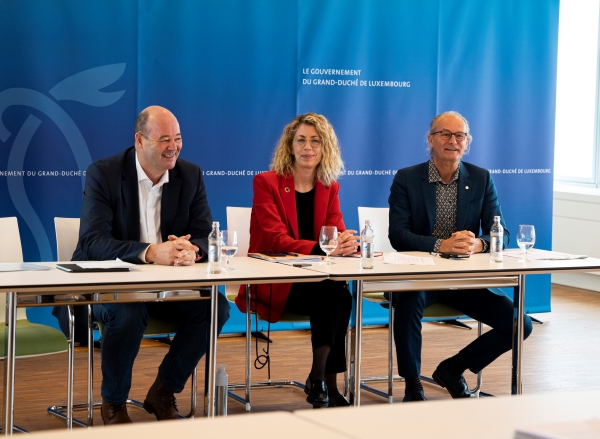 (L-R) Claude Haagen, Minister of Agriculture, Viticulture and Rural Development; Joëlle Welfring, Minister of Environment, Climate and Sustainable Development; Claude Turmes, Minister of Energy;
Credit: MEA
(L-R) Claude Haagen, Minister of Agriculture, Viticulture and Rural Development; Joëlle Welfring, Minister of Environment, Climate and Sustainable Development; Claude Turmes, Minister of Energy;
Credit: MEA
On Thursday 20 October 2022, Luxembourg's Minister of Energy, Claude Turmes, the Minister of Agriculture, Viticulture and Rural Development, Claude Haagen, and the Minister of the Environment, Climate and Sustainable Development, Joëlle Welfring, presented a call for tenders for pilot projects dedicated to the construction and operation of agrivoltaic power plants, which aims to reconcile renewable electricity production and agricultural production, while promoting the development of biodiversity.
Minister Turmes underlined: “Solar energy plays a central role in the energy transition in Luxembourg. This pilot project for agrivoltaic power plants, a precursor in this field, will enable farmers to become full players in this transition towards clean and locally produced energy production, which will allow us to strengthen our independence from 'fossil fuels' energy exporting countries."
Minister Haagen specified: “This agricultural land must remain primarily dedicated to the sustainable production of foodstuffs and will therefore continue to be eligible for the area aid provided for under the common agricultural policy.”
Minister Welfring said: "This pilot project aims to demonstrate to what extent synergies and interests can be found between the development of renewable energy, the protection of nature and agricultural practice in Luxembourg. It is interesting from an ecological point of view that we are pursuing the energy transition while promoting biodiversity in Luxembourg. As all the projects will be subject to ecological monitoring, and more particularly of the flora, I am curious and impatient to read the related results carefully.”
The specifications for this call for tenders and the accompanying documents were drawn up in consultation between the three ministries and their services, and after consultation with experts in the field of installations on vacant land in agricultural areas. In addition, all the actors concerned, including NGOs, were brought together during a workshop to collect their reactions on the subject.
For the Ministry of Energy and Spatial Planning, the initiating ministry, the development of solar energy on roofs, as well as on sealed surfaces, remains at the centre of the government's solar strategy. To complement this strategy, other facilities will be needed in the future to achieve the ambitious goals of the National Integrated Energy and Climate Plan (PNEC). According to the ministry, this agrivoltaic power plant pilot project serves to prepare for the future in a coherent way, trying to achieve the triple beneficial situation described above.
For the Ministry of Environment, Climate and Sustainable Development, the aspect of protecting and promoting biodiversity is of crucial importance. Specifically for this purpose, specifications have been drawn up which combine, from the planning stage, extensive agricultural practice, the optimisation of biodiversity (fauna and flora) and the protection of nature on a site. A monitoring ensures the follow-up of the project and the good development of the sites.
Currently, the revision of the national plan for nature protection is in the public consultation phase.
1. Details of the pilot call for tenders for agrivoltaic power plants
Categorisation according to the agricultural use of the project and the type of photovoltaic installation:
- Lot 1: Floor-mounted power plants, vertical bifacial panel power plants or Tracker
- Category 1: Grassland used for fodder production;
- Category 2: Grassland used for animal husbandry (including poultry farming);
- Category 3: Arable land for all crops [including special crops such as market gardening, viticulture or arboriculture (fruit trees)].
- Lot 2: Canopies: New raised structure, open on the sides, serving as a support for the photovoltaic panels. The panels can be fixed or mobile. Farming takes place below the panels.
- Category 4: Special crops.
The power plants can have a power between 100 kW and 5 MW, with a special provision for land subject to conversion after landfill backfilling work. The total volume targeted is 50 MW of power. The allocation is made at the best price, with at least two projects per category and priority to installations of less than or equal to 2 MW.
One of the objectives of the pilot project is to allocate projects in the different categories to obtain a diversity of projects and to ensure their follow-up and evolution. To this end, regular monitoring will be put in place.
The ecological and agricultural factors are eliminatory criteria: if the pilot project does not comply with them, the offer is eliminated.
The developer of a project must present a concept allowing an improvement of the ecological quality of the surface. To this end, a toolkit has been developed to guide developers.
As far as the agricultural concept is concerned, this must allow the continuation of the agricultural exploitation of the area with the obligatory association of an active farmer.
The deadline for submitting projects is 1 August 2023.
2. State of play: growth of photovoltaic installations in Luxembourg
In 2020, the photovoltaic panels installed on the territory have already covered the electricity needs of around 120,000 people − a trend that was confirmed in 2021 with 1,264 new photovoltaic power plants installed, which is equivalent to over 90 MW. This increase is fifteen times bigger than in 2017. At the end of 2021, almost 10,000 photovoltaic power plants with an installed capacity of 277 MW were therefore connected to the network, able to cover the electricity needs of around 180,000 people. Reaching the 50 MW targeted by this call for tenders would therefore represent an increase of almost 20% of the existing capacity.








